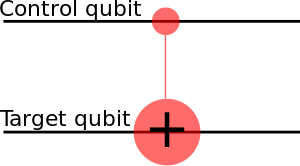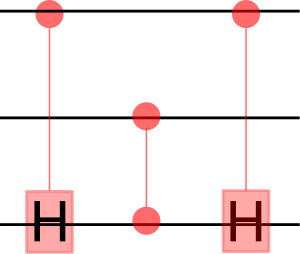Qiskit: Difference between revisions
No edit summary |
|||
| Line 6: | Line 6: | ||
https://quantum-computing.ibm.com/jupyter/user/IBMQuantumChallenge2020/week-1/ex_1a_en.ipynb | https://quantum-computing.ibm.com/jupyter/user/IBMQuantumChallenge2020/week-1/ex_1a_en.ipynb | ||
=== Installation === | === Installation === | ||
| Line 54: | Line 52: | ||
Qiskit allows measuring in the Z-basis, only. | Qiskit allows measuring in the Z-basis, only. | ||
== Theory == | |||
Quantum operations are reversible, thus the reversible computing. That makes some ''complications'' to the gate design. | |||
=== Quantum Gates === | === Quantum Gates === | ||
Revision as of 18:02, 22 November 2020
Introduction
https://quantum-computing.ibm.com/
https://quantum-computing.ibm.com/challenges/fall-2020
https://quantum-computing.ibm.com/jupyter/user/IBMQuantumChallenge2020/week-1/ex_1a_en.ipynb
Installation
Installation https://qiskit.org/documentation/install.html
conda create -n qiskit python=3
conda activate qiskit
pip install qiskit _OR_ pip install qiskit[visualization]Setting Up Qiskit
https://qiskit.org/textbook/ch-states/representing-qubit-states.html
qc = QuantumCircuit(1) # Create a quantum circuit with one qubit
initial_state = [0,1] # Define initial_state as |1>
qc.initialize(initial_state, 0) # Apply initialisation operation to the 0th qubit
qc.draw('text') # Let's view our circuit (text drawing is required for the 'Initialize' gate due to a known bug in qiskit)
result = execute(qc,backend).result() # Do the simulation, returning the result
out_state = result.get_statevector()
print(out_state) # Display the output state vectorqc.measure_all()
qc.draw()
result = execute(qc,backend).result()
counts = result.get_counts()
plot_histogram(counts)Take superposition as initial state
initial_state = [1/sqrt(2), 1j/sqrt(2)] # Define state |q>The Bloch Sphere
from qiskit_textbook.widgets import plot_bloch_vector_spherical
coords = [pi/2,0,1] # [Theta, Phi, Radius]
plot_bloch_vector_spherical(coords) # Bloch Vector with spherical coordinatesQiskit allows measuring in the Z-basis, only.
Theory
Quantum operations are reversible, thus the reversible computing. That makes some complications to the gate design.
Quantum Gates
Identity gate.
Pauli X gate.
Pauli Y gate
Pauli Z gate
R gate
S gate or gate
T gate
U1 gate:
U2 gate:
qc = QuantumCircuit(1)
qc.x(0)
#qc.y(0) # Y-gate on qubit 0
#qc.z(0) # Z-gate on qubit 0
#qc.rz(pi/4, 0)
#qc.s(0) # Apply S-gate to qubit 0
#qc.sdg(0) # Apply Sdg-gate to qubit 0
qc.t(0) # Apply T-gate to qubit 0
qc.tdg(0) # Apply Tdg-gate to qubit 0
qc.draw('mpl')
# Let's see the result
backend = Aer.get_backend('statevector_simulator')
out = execute(qc,backend).result().get_statevector()
plot_bloch_multivector(out)
Multiple Qubits
Eg. .
backend = Aer.get_backend('unitary_simulator')
unitary = execute(qc,backend).result().get_unitary()
#
# In Jupyter Notebooks we can display this nicely using Latex.
# If not using Jupyter Notebooks you may need to remove the
# array_to_latex function and use print(unitary) instead.
from qiskit_textbook.tools import array_to_latex
array_to_latex(unitary, pretext="\\text{Circuit = }\n")
Eg. CNOT is a conditional gate that performs an X-gate on the second qubit, if the state of the first qubit (control) is . . This matrix swaps the amplitudes of |01⟩ and |11⟩ in the statevector.
CNOT if a control qubit is on the superposition:
, which is Bell State. Entanglement, but no-communication theorem.
. Unchanged.
.
. Affects the state of the control qubit, only.
qc = QuantumCircuit(2)
# Apply H-gate to the first:
qc.h(0)
# Apply a CNOT:
qc.cx(0,1)
qc.draw()
#
# Let's see the result:
backend = Aer.get_backend('statevector_simulator')
final_state = execute(qc,backend).result().get_statevector()
# Print the statevector neatly:
array_to_latex(final_state, pretext="\\text{Statevector = }")
#
results = execute(qc,backend).result().get_counts()
plot_histogram(results)
Any controlled quantum gate is and in Qiskit formalism is written in matrix as
Controlled-Z. Because and we can write
qc = QuantumCircuit(2)
# also a controlled-Z
qc.h(t)
qc.cx(c,t)
qc.h(t)
qc.draw()Controlled-Y is
qc = QuantumCircuit(2)
# a controlled-Y
qc.sdg(t)
qc.cx(c,t)
qc.s(t)
qc.draw()or Controlled-H is
qc = QuantumCircuit(2)
# a controlled-H
qc.ry(pi/4,t)
qc.cx(c,t)
qc.ry(-pi/4,t)
qc.draw()Swap gate
An arbitrary controlled-controlled-U for any single-qubit rotation U. We need and
#The controls are qubits a and b, and the target is qubit t.
#Subroutines cu1(theta,c,t) and cu1(-theta,c,t) need to be defined
qc = QuantumCircuit(3)
qc.cu1(theta,b,t)
qc.cx(a,b)
qc.cu1(-theta,b,t)
qc.cx(a,b)
qc.cu1(theta,a,t)
qc.draw()Toffoli gate performs on target qubit if both control cubits are set to state .
qc = QuantumCircuit(3)
a = 0
b = 1
t = 2
# Toffoli with control qubits a and b and target t
qc.ccx(a,b,t)
qc.draw()
Toffoli using CNOTs uses fewer gates.
qc = QuantumCircuit(3)
qc.ch(a,t)
qc.cz(b,t)
qc.ch(a,t)
qc.draw()Clifford Gates
Exercises
Week 1
Week 2
Week 3


























